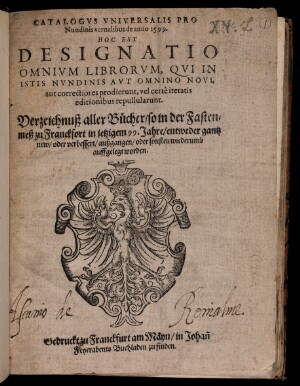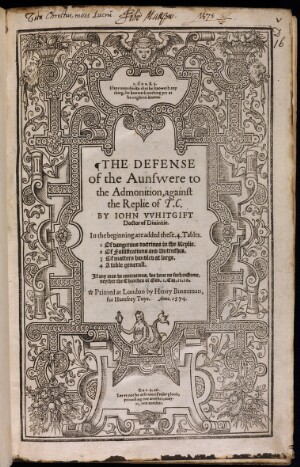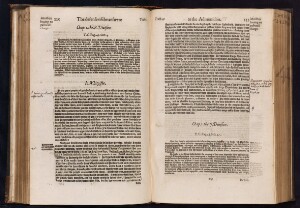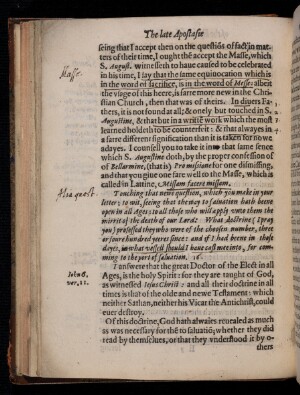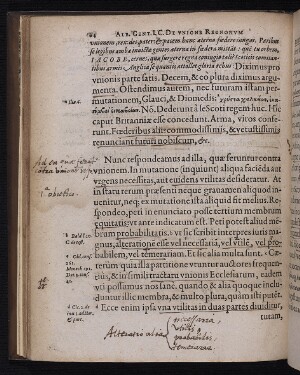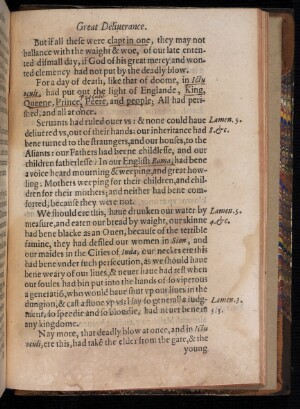Tobie Matthew's Library
Rosamund Oates (Manchester Metropolitan University)
In his will, Matthew noted: 'it hath pleased God to appoint me an assiduous preacher in those eminent places of the Church' (1). Preaching was the most important part of Matthew's clerical role: he believed that 'faith cometh by hearing, and hearing the word of God' (2). Throughout his career he was committed to a punishing schedule of preaching, delivering at least one sermon a week — if not more — in the dioceses of Durham and York, and in London and Oxford. As a result, Matthew was a reader — not a writer. He collected and annotated a wide range of books for himself, as well as for others, to use in the pulpit.
As a result, biblical commentaries and translations — including works in Greek and Hebrew — formed a large part of his collection. His sermons always took as their starting point a biblical text, which he then explained using scriptural guides and contemporary theologies. Matthew also needed to make the biblical message relevant to his different congregations, for while the Scriptures stayed the same, the circumstances of people's lives changed. In addition to scriptural exegeses, Matthew used histories, polemics and news of recent events at home and abroad to make his sermons accessible to his different congregations. This explains the wide range of subjects covered in Matthew's library. He read legal texts, histories, Catholic and anti-Catholic polemics, news pamphlets and other peoples' sermons. All of these fed into his sermons, and into the sermons of his chaplains and colleagues. Matthew's collection also reflects his work for the Tudor and Stuart regimes, promoting government policies in Durham, York and London.
Building a Collection
Matthew's collection of books seems to have been a deliberate attempt to build, and curate, a collection of books that he, and others, could use for their pastoral and political work. Matthew was an active collector. He bought books from booksellers in London, Oxford and Frankfurt, and when he couldn't get hold of them himself he asked his family and friends to step in. In 1594, Matthew wrote to the historian William Camden from Durham, asking him to pick up a book for him in London. He was fairly vague in his request, facing a problem familiar to regular bookshop browsers. Matthew remembered seeing 'a work in two or three volumes', but admitted 'I have forgotten the author's name, only this I remember, it was a mixed work of divinity and laws, canon and civil'; he thought this legal guide would 'do me much ease and stand me in good stead' (3). Friends and family sent him books throughout his time in Durham and York. In 1619, he arranged for his nephew to pick up a selection of theological and polemical pamphlets from his friend, Samuel Ward, and to get them bound for him in either London or Cambridge. Matthew's frustration at being far away from the centre of the book trade is palpable. Matthew wrote from York to thank his friend, Chancellor of the Exchequer, Julius Caesar for 'the great bundle of books received from you ... such is your advantage that live there [London]', Matthew wrote, compared to us 'so far off from the well head' (4).
From 1595, when he became Bishop of Durham, Matthew's other main source of books was the Frankfurt book fair. He received the Frankfurt book catalogue every six months. These catalogues were an important source of information about European publishing, and Matthew marked up books of note as well as books he wanted to buy, using an agent to purchase them. Sometimes, his agent took matters into his own hand — sending him additional books that he thought Matthew would like (Fig. 1).
Not all of his books were deliberate purchases. Matthew was sent books as gifts, including by authors who dedicated their works to him. Sometimes, this was a long standing friendship, as in the case of the Italian protestant émigré, Alberico Gentili, who dedicated Maleficis et Math (1593) to Matthew, thanking him for his long years of support, and continued to send him copies of his work (5). Friends and family sent Matthew copies of their recent publications, including his cousin James Calfhill, who in 1565 gave him a copy of An Answer to the Treatise of the Crosse with a dedicatory verse. Other authors sent him their books in the hope of future patronage. In 1613, for example, the clergyman and polemicist Robert Abbot sent Matthew a presentation copy of his work, Apologeticum pro Garneto, antilogia. Matthew also inherited, or sometimes bought, books from friends and colleagues when they died. His collection includes books that were owned by colleagues in York and Durham, as well as books that previously belonged to old friends, like Bishop Barnes and his sons. Matthew further augmented his collection by borrowing books from friends, including Matthew Hutton — archbishop of York before him — and Lord Ferdinando Fairfax (6).
Using the Library
Matthew's library was a working library. He kept most of his books at the archiepiscopal palace at Cawood Castle, but when he died there were also 'divers books, both divinity and humanity' at York. Although he had a study at Cawood, he seems to have kept the majority of his collection in his bedchamber — it was here that he had a 'large frame for books' (a bookcase) valued at 16s 4d. The bedchamber was a quiet place, and he may have made a distinction between his archiepiscopal work, which he conducted in his study, and his reading. This doesn't necessarily imply that his collection was private, but rather that he — like many godly divines — did a lot of their spiritual reading in the relative privacy of the bedchamber (7).
Many of his books are signed by him, usually with the appropriate title (for example 'Tobias Eboracen') and often with his motto: 'Vita Christus mors lucrum' (Fig. 2). Matthew also read his books with a pen in his hand, making notes for himself and others in margin. His chaplain, John Favour, who used Matthew's library, recorded that Matthew 'hath not only read all the Ancient fathers with a diligent eye, but hath also noted them with a judicious pen' (8).
John Whitgift, The Defense of the Aunswere (London, 1574), York Minster, XV.C.19
In the pulpit Matthew had to defend the established Church from attacks by Protestants and Catholics. During the 1580s, a more radical group of Protestants pressed for Presbyterianism in England, arguing that this would make the English church more like its Calvinist cousins abroad.
In 1575, a year after it was published, Matthew acquired a copy of John Whitgift's The Defense of the Aunswere to the Admonition (London, 1574) (see Fig. 2). This was part of the polemical argument between John Whitgift — apologist for the Church of England, and later archbishop of Canterbury — and the theologian Thomas Cartwright. Cartwright and his friends criticised the structure of the English Church, attacked the episcopacy and called for more Calvinist reforms. In the way of polemics in this period, Whitgift repeated Cartwright's arguments at length in order to refute them, which meant The Defense of the Aunswere could be read as a neat summary of the argument so far. This is exactly how Matthew read it, making notes along the way to guide him, to summarise the text and for quick reference.
The pages here show how Matthew highlighted arguments made by Whitgift and Cartwright (Fig. 3). As a conformist, Matthew's sympathies lay firmly with Whitgift and his defence of episcopacy, but his Puritan tendencies meant that he agreed with some of Cartwright's criticisms of the Church. In this section on episcopacy, however, it is apparent that Matthew's sympathies are firmly with Whitgift. He underlines the chief points of Cartwright's argument, highlighting the main thrust of his concern and also highlights Whitgift's answer. His note in the margin — 'a point excellently answered' — looks like a note by Matthew for himself to remember Whitgift's argument. Elsewhere, Matthew has drawn a trefoil, one of several symbols he used to remind himself to copy a passage or reference into one of his notebooks. There are also notes which Matthew made to ease his own reading, and help him digest the material. For example, on p. 221, Matthew has summarised the main point of Whitgift's argument, writing 'Magistrates as well as Ministers called shepherds and watchmen'. Matthew repeated this argument in several of his sermons over the next decade. There are also page references in the margins, where Matthew provides an internal reference to another, related, passage in the same book. Sometimes, he also adds a reference to another work.
Daniel Tilenus, The True Copy of Two Letters with their several answeres contayning the late Apostasie of the Earl of Lavall after his return from Italy (London, 1605), York Minster, XVII/2.H.8(2)
This volume contains examples of reading that appears more private, and more familiar to modern readers. He clearly signposts his way through the text, writing 'Mass' above the discussion of the antiquity of the Catholic mass (Fig. 4). In another place, he writes 'Alia Quest' next to a passage when the convert asks how Christians got to heaven before Luther. Matthew highlights sections of the reply, and writes a note to himself 'lege, relege' (read, re-read) next to a reference to the 'Book of the Catalogue of the Witnesses of the truth'. This may be a reference to Matthias Illyricus Flaccius, Catalogus Testium Veritatis (Basel, 1562), which Matthew also owned.
Alberico Gentilis, Regales Disputationes Tres (Thomas Vautrollerium, London, 1605), York Minster, III.L.30
This book illustrates how Matthew read for information, using Gentili's discussion of an Anglo-Scottish Union for his speech in parliament on the topic — part of Matthew's attempt to gain favour with James I. He makes a note in the margin about how Gentili replies to critics of the Union, highlighting common arguments against a political union with Scotland and Gentili's response (Fig. 5). At the bottom of the page, he makes notes — apparently for himself — on the effects of a change in Anglo-Scottish relations.
Matthew was involved in promoting the Union from the earliest days of James' reign in 1603, and his notes on Gentili's book was part of an ongoing conversation between Matthew and Gentili. In 1604, Matthew asked Gentili for help with examples of political unions, and Gentili replied with some Spanish examples from the book he was working on — Regales Disputationes Tres, published the following year. Gentili and Matthew had a long friendship and Matthew provided support for Gentili when he arrived as a Protestant exile from Italy in Oxford. Gentili dedicated one of his books, Maleficium et Math, to Matthew and the presentation copy is among Matthew's collection.
William Leigh, Great Britaines Great deliverance from the great danger of popish powder (Arthur Johnson, London, 1606), York Minster, XVII/2.J.14(5)
Another large part of Matthew's library consists of more ephemeral works, pamphlets produced quickly and relatively cheaply in response to the big events. Matthew read these to keep up to date with events in London and Europe, and he mined them for details to use in his sermons. Part of the purpose of a sermon was to make it applicable and fresh for listeners, and Matthew needed to show God's will in contemporary affairs.
Matthew was in London during the Gunpowder Plot — he was meant to be in the parliament that Robert Catesby and Guy Fawkes tried to blow up. He preached the first sermon in front of James I after the discovery of the plot, and was part of the team who quickly used it as evidence that God was on James' side and Catholics were potential traitors. After 1605, Matthew preached most years on the anniversary of the Gunpowder Plot, and his sermons were often accompanied by bonfires — forerunners of modern Bonfire Night celebrations. In this pamphlet by William Leigh, Matthew has made notes on some of the details of the plotters and quite how close they came to blowing up parliament — presumably for some of these sermons (Fig. 6). He could not help, however, adding a note about his own role. In Leigh's list of who would have been blown up, 'Princes, magistrates, nobles', Matthew has added 'Prelates' between princes and magistrates — determined that no one will overlook his proximity to the danger!
(1) York, Borthwick Institute of Historical Research, Probate Register 40, fol. 195r.
(2) Oxford, St John's College, MS 212, p. 39.
(3) London, British Library, MS Cotton Julius V, fol. 53r.
(4) London, British Library, MS Lansdowne MS 161, fol. 278r.
(5) York Minster, III.L.29, dedicatory epistle.
(6) London, Lambeth Palace, MS Tenison 3203, fol. 576 r.
(7) J. Raine, A Catalogue of the Printed Books in the Library of the Dean and Chapter of York (York: John Sampson, 1896), p. ix.
(8) John Favour, Antiquitie Triumphing ouer Noveltie (London: Richard Field, 1619), dedicatory preface.
